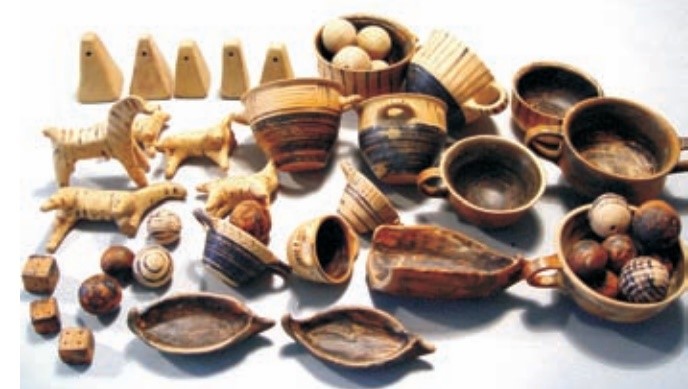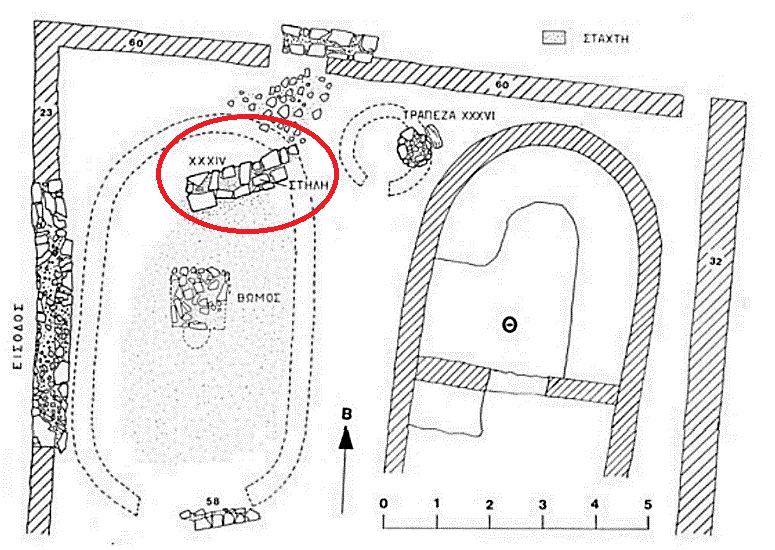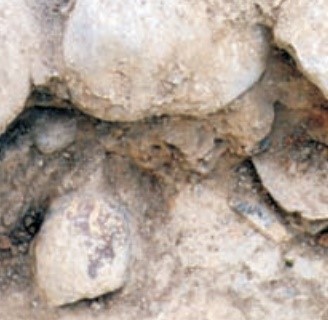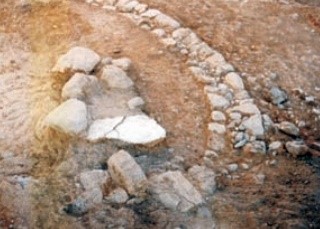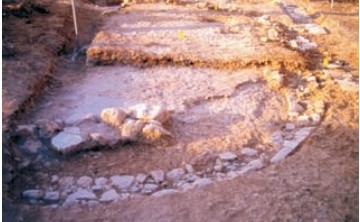The model preserves a large portion of the hull, including the entire stern and bottom of the sternpost. The outside of model is painted red, while the interior painted in a darker colour. A diagonal band on the base of the sternpost is discernible, possibly indicating that the whole model was originally decorated with a linear pattern.
Ship model
A33
Late 8th- early 7th c.
Oropos, O.S.K. plot. Central Quarter, on top of so-called 'cenotaph'
L: 12 cm; H: 7.2 cm;
Fragmentary terracotta model. Exterior painted red, interior painted in a darker colour
ΩΚ/Πε 19
Pérez 2007: 325-327, figs. 11-13
EIA Oropos is known from two nuclei of
habitation about 700m apart (Mazarakis 1998). The earliest eastern area of
occupation (O.T.E. plot) is represented by pottery of LPG to the SPG III
date (late 10th-mid 9th century) which shows close affinities with
the contemporary ceramic production at Lefkandi. NAA analysis indicates
that this locally produced pottery is connected with the clay bed at
Phylla near Lefkandi, opening the possibility that the clay was shipped
over.1 This area was still (sparsely) occupied during the LG and
Archaic periods. The second area to the west (O.S.K. plot) consists of a
much more extensive settlement inhabited from the beginning of the LG to
the end of the Archaic period (8th-7th centuries), showing a
combination of industrial, household, religious, and funerary
activities. This area is best known for its extensive industrial
quarter, involving varied metalworking activities both inside buildings
and in the courtyards outside (iron and bronze secondary working such as
casting, fabrication and forging), as well as other artisan practices
such as ceramic workshops which were found scattered among the
dwellings.
Maritime activities at the site are attested from the central
and west quarter which have yielded a bronze fish hook, numerous lead
net-weights, and a large amount of sea shells (Pérez 2007: 325, n. 33.). Forty-one different
shell species were found in the settlement, with the purple dye murex
being amongst the most common. The systematic presence of sea-shells in
all areas of the settlement throughout its occupation history indicates
that they were used in a variety of ways: as part of the diet, as burial
offerings and even as tools. The association of murex shells in
relatively large numbers with loom weights suggests that purple dye
industry was practiced, albeit on a small scale (Mazarakis and Mouliou 2008). Some of the finds
furthermore suggest contacts with the east, such as glass beads,
sealstones of steatite, a faience scarab, a scaraboid of red serpentine,
and a perfumed bottle in the shape of a monkey. These mostly come from
the occupation levels rather than the tombs.
1. It is possible however that the clay beds around Oropos, which are not yet investigated, had a similar chemical composition (Mazarakis and Vlachou 2014).
Oropos undeniably shows strong connections with Euboea and Lefkandi in
particular already from the end of PG. This is not only demonstrated by
the ceramic repertoire, but also its LG-EA buildings which are quite
similar to those from Eretria and Lefkandi (oval and apsidal plans).
Mazarakis has further argued that Euboean sites (including Oropos) also
share a pattern in the use of household space, which points to a similar
social organisation. Finally, an inscribed stone disc dated to the
second half of the 8th century found on the threshold of oval building
I points to the Eretrian alphabet, as suggested by the way the M is
rendered in the inscription which bears the name of its owner,
Peithalimos. The evidence is thus fairly clear that Oropos was
culturally aligned with Euboea both in PG-SPG (O.T.E. plot) and during
the Geometric period (O.S.K. plot). If Lefkandi is to be identified as
Strabo's "Old Eretria" (9, 403; 10, 448), Oropos could be seen as an
outpost in the PG-SPG periods. In any case, it is clear that the two
sites followed a parallel trajectory, and it is interesting that the
latest SPG material from O.T.E is contemporary with the PSG IIIa phase
at Lefkandi which was the period immediately prior to the abandonment of
its cemeteries c. 825. Mazarakis notes that it is probably not a
coincidence that the decline of Lefkandi is synchronous both with the
foundation of the industrial quarter at Oropos and the foundation of
Eretria. A parallel has also been drawn with Pithekoussai which, like
Oropos and Eretria, shows that metalworking was a primary activity at
the site, while the apsidal buildings Θ at Oropos and Building I at
Pithekoussai have been interpreted to have served analogous functions as
possible elite dwellings. Mazarakis has suggested that Oropos likely
participated in the colonisation west under the aegis of Eretria, while
the presence of imported 8th century Silver Slip Ware from Macedonia
hints at a similar involvement in the thermaic gulf and Chalkidike (Mazarakis 2012: 80-81; 2007:13, pl. 13β).
A33 Context: A cult assemblage dating to the early 7th century was
found partly overlaying the ruined oval building IA, within the limits
of the great peribolos (XXXIV) and contemporary with the period during
which a monumental 5m wide entrance was opened in the middle of its West
side (wall 23). Over the previous hearth of the building was built a
rectangular paved structure which probably functioned as an altar given
that it was covered with ashes, with a handmade lamp as well as
mutilated terracotta horse figurines found in the vicinity. Immediately
to its north was a rectangular stone platform/bench-like structure (c. 2
x 0.7 m), with a roughly dressed rectangular stone set in an upright
position in the middle of the 'bench', reminiscent of a grave
marker/sema. No human bones however were found after the removal of
the stones, while many smashed vases (kotylai, cups and skyphoi, small
perfume or oil bottles, pouring vessels, etc.) - some of which showed
signs of burning - as well as small finds (including a few metal
items), ashes, charcoal, calcinated animal bones and sea shells were
found around this structure. The boat model was found abutting a stone
cenotaph and has thus been interpreted as a possible gift to a hero lost
at sea. A small circular offering table was also located nearby.
Mazarakis has interpreted this context as a potential hero cult.
Two more boat models dating to the second half of the 6th century were found one inside the other in the west quarter along with a dog and cat figurine. ΩΔ/Πε 24 is nearly complete (L:12 cm; H: 4.2 cm) and similar to boat from the cenotaph, being homogenously painted in red englobe. It has a helm-fin at the stern. ΩΔ/Πε 25 is intact. It has a shallow hull, a vertical stempost with a beaked bow projection and an incurving sternpost. All of the Oropos boat models attest to extensive use of colour (black and/or red englobe). Boat models dating to the end of the 7th century have also been found at the Pastola locality of Pithekoussai, in what has been interpreted as possibly a sanctuary of Hero associated with a hero cult. (d'Agostino 1994-95: 9-108, pls. VIII-XI, XXII-XXIII.).
Pérez, M. A. 2007. “Figurines and Boat Models from the Early Iron Age Settlement at Oropos,” in A. A. Mazarakis (ed.) Oropos and Euboea in the Early Iron Age: Acts of an International Round Table, University of Thessaly, June 18-20, 2004. Volos: University of Thessaly Publications, pp. 319-330.



